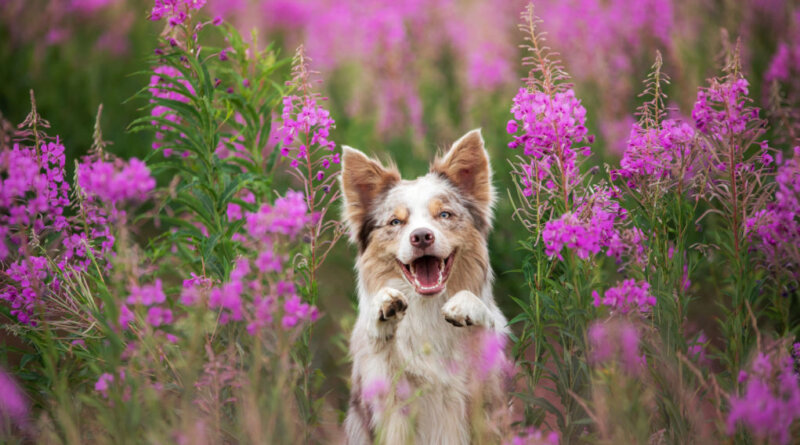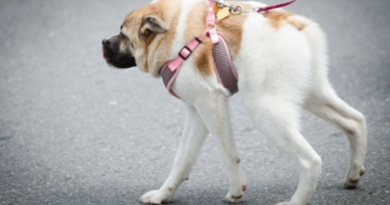Do Dogs Act Different in Spring? – Top Dog Tips
Dogs are cheerful pets, but do dogs act differently in spring?
This is a question a lot of dog owners ask, especially new ones.
The thing is, dog in-season behaviors are a common phenomenon, even in other animals.
This is a result of the changing amounts of daylight and how the body responds to it.
So today, we’ve worked on helping you answer the same question by laying out all the vital changes you might notice in your dogs in spring.
So, read on and learn more about this topic before your dog springs into action (no pun intended).
Do Dogs Act Different in Spring?
According to studies, dogs act differently in spring due to the longer daylight and slightly warmer temperatures.
You may notice your dogs shedding a lot or getting a little extra when the sun is out.
Moreover, springtime also makes dogs feel the urge to mate.
So, be sure to supervise your Fidos at all times when outdoors. This is to avoid aggression and fights towards other pets due to raging hormones.
Dogs Acting Different in Spring: 11 Changes, Illnesses & Risks
Common Physical and Behavioral Changes
Dogs act differently in spring and here are a few physical and behavioral changes you might notice in them along the way.
1. Dogs Shedding a Little Too Much
Due to seasonal changes, dogs shed winter coats to welcome the new, warm weather.
While spring shedding isn’t noticeable in some dog breeds, this phenomenon is common when their bodies undergo shifting temperatures.
Tip: Use a good-quality de-shedding brush to remove loose hair in your dogs effectively.
Dogs shed hair naturally, and this is an indication that they’re healthy.
However, excessive shedding in dogs can also be a sign of the following:
- Stress
- Pregnancy
- Skin trauma
- Poor nutrition
- Food Allergies
- Serious illnesses
- Parasitic infections
- Inappropriate medications
- Misused grooming products
With this in mind, you might need to try a new dog food brand or change certain treatments as prescribed by your vet.
Moreover, be sure to hydrate your Fidos with a sufficient amount of fresh water every day.
Trivia: Long-haired dog breeds aren’t necessarily the biggest shedders.
Dogs that shed the most include the following:
2. Fido’s Energy Starts Elevating
Nope, it’s not just the zoomies. It’s the spring fever!
When the weather starts warming up, dogs get all excited and ecstatic to let their paws out in the sun.
You might ask: “Why do dogs have increased energy in spring?”
Studies reveal that light is the primary factor influencing human and animal hormone production.
Hormones such as cortisol and melatonin are synthesized in the body in response to light through the retina in the eyes.
And according to another study, melatonin (the sleep hormone) in dogs increases in gloomy seasons like winter, especially in high-latitude areas or locations with the least sunlight.
The opposite is true when the days are longer and the sun shines brighter.
So, taking your dogs outdoors or to creative dog parks in spring is definitely a great idea.
3. Dogs Become Ecstatic to Socialize With Other Pets
Dogs are innately social but tend to get a little extra when meeting new furry friends in spring.
In general, socializing your dogs is vital in their relationship with owners and other pets — at home or outdoors.
It allows them to build fur-riendships without fear, aggression, or anxiety.
However, dogs who lack socialization also tend to be the following:
- Sound-sensitive
- Difficult to handle
- Nervous around people
Tip: You can take advantage of the spring season to train your dogs.
The longer and sunnier days of spring are convenient for obedience or potty training.
Moreover, engaging your fur buddies in exciting activities like playing benefits their physical and emotional development.
The earlier your dogs start socializing, the easier they can interact with their surroundings.
4. More Chances of Dog Mating
While there’s no specific period of mating in most dogs, they often get in heat during spring.
But why do dogs often mate in spring?
According to a study, the testosterone hormone in male dogs is higher in spring and autumn than in summer.
That’s because day length and temperature are two vital factors in the reproductive health of dogs.
However, dog hormone levels may drop in tropical areas where temperatures are higher and rainfalls are substantial.
Furthermore, female dogs which are in heat often have swollen vulvae and experience bleeding.
Meanwhile, male dogs usually urinate in the same few spots or spray markings. They may also tend to show dominance at times.
5. Dogs Can Get Territorial, Too
In addition to the previous item, dogs can get territorial when exposed outdoors or even at home.
That’s because dogs in spring have raging hormones, especially the male ones.
A few other reasons why dogs get territorial are the following:
- Stress
- Undersocialization
- Fighting over dominance
- Underlying medical condition
Meanwhile, dogs in spring can get aggressive towards new animals they see within their territory.
And despite your efforts to stop them, they’ll most likely chase after these animals no matter what.
Trivia: Dogs in spring usually have selective hearing.
They may not respond quickly when called due to various sounds they hear or spring animals they see in their environment, such as squirrels, birds, and chipmunks.
So, it’s best to soundproof your surroundings whenever you can or supervise your Fidos at home and outdoors at all times.
Relevant Read: Dogs Marking Their Territory and How To Stop Them
Common Seasonal Illnesses in Dogs
Dogs also act differently in spring due to some illnesses brought about by this budding season.
Here are the most common health conditions you must look out for at this time of the year.
6. Overheating or Heat Stress
While the spring heat is much calmer than summer, dogs are still prone to overheating.
According to a study, overheating in dogs is characterized by a body temperature of more than 40°C.
Moreover, dog weight and the level of physical activity are also contributing factors to heatstroke.
Meanwhile, a lack of physical exercise can also trigger overheating in dogs. That said, outdoor activities can help them regulate body temperature.
The more dogs are isolated at home, the more difficult for them to adjust to the outside temperature.
So, take advantage of the spring season to condition your Fido’s health. But be sure to supervise them at all times.
Plus, bringing enough amount of water is a must.
Tip: It’s best to choose big dog parks with lots of shade structures or trees so your pups can rest.
7. Seasonal Allergies
Despite the excitement that spring brings, your furry friends may get under the weather while out in the open.
Like humans, dogs can also get seasonal allergies caused by allergens in the air, such as:
This can make their skin itch resulting in irritations due to scratching.
For your reference, here are some common signs of seasonal allergies in dogs:
- Rubbing their face
- Licking their paws
- Skin inflammation
- Frequent sneezing
- Rubbing their bottom on the floor
- Biting their coat or skin excessively
Meanwhile, you can look for remedies to treat seasonal allergies and infections, such as:
- Allergy shots
- Grooming products
- Antihistamine medications
However, it’s recommended to seek your vet’s advice for proper treatments corresponding to your dog’s health history.
Relevant Read: How To Care for Your Dog During Spring
8. Parasitic Infections
Not only are allergens the main culprit of illnesses in dogs during spring, but so are parasites.
Ticks and fleas can wreak havoc on your pets during this time of the year.
That’s because high temperatures can trigger parasite growth, a study reveals.
As a result, tick and flea bites and infestations can cause the following conditions in dogs:
- Anemia
- Irritation
- Tick paralysis
- Self-wound formation
- Vector-borne pathogens (VBPs) transmission
For tick and flea prevention and treatment, here are a few suggestions to help you get started:
Furthermore, don’t forget to take your dog to the vet for a deworming session as intestinal parasites can activate more in spring due to the warm weather.
Potential Risks of Dogs While Outdoors
Dogs act different in spring due to their heightened senses. They sometimes get into trouble, such as the following:
9. Accidents and Injuries
There’s something about spring that makes dogs get a little extra.
However, playtimes can sometimes lead to unwanted trips to the vet, such as running into the streets while catching that frisbee disc.
Plus, your dogs may encounter an aggressive pooch while strolling in the park. So, take extra caution.
Tip: When socializing dogs outdoors, avoid forcing them to get to know each other. It’s best to let them take the lead.
Moreover, here are a few dog safety essentials to bring before taking your Fidos outdoors:
10. Wildlife Encounter
Another risk in this budding season is the emergence of wildlife outdoors.
From birds and squirrels to rabbits, dogs might not resist chasing everything that’s lurking in their territory.
However, some wild animals, like rabbits, carry infectious diseases, such as:
- Rabies
- Tularemia
- Ringworms
- Pasteurellosis
Moreover, wild mammals can get aggressive when other animals invade their nests or get too close to their offspring.
Training your dog to follow commands, especially dealing with other animals, is important.
But, for safety reasons, it’s best to supervise your dogs while roaming outdoors.
Animal-proofing your home can also help prevent unwanted encounters with wild animals.
Important: The same prevention goes to livestock animals like chickens, ducks, and goats.
Be sure to secure your farm friends from pests, wild animals, and… your dog, too.
Relevant Read: DIY Puppy Proofing: 7 Quick Tips to Pet Proof Your Home
11. Exposure to Poisonous Plants
The blooming flowers in spring may look elegant and pleasing to the eyes. But, hold up, not all flowers and plants are pet-friendly.
Here are some of the deadliest plants for your dogs:
Poppy
Poppies may have striking red petals, but they’re a hazard to your dog’s health.
According to a study, poppies contain opium alkaloids or a narcotic compound that can affect behavior.
In general, opium is used for pain relief and other medications, but they’re dangerous when ingested by animals.
When dogs accidentally eat this plant, it can lead to the following:
- Death
- Seizures
- Breathing difficulty
Water Hemlock
Water Hemlocks are a great addition to nature’s beauty, but it’s a “violently toxic plant that grows in North America” according to the USDA.
That’s because this plant contains cicutoxin which affects the nervous system in animals.
When ingested, dogs may experience the following:
- Seizures
- Drooling
- Muscle cramps
- Breathing difficulty
Danger: All parts of the Water Hemlock contain this deadly toxin.
It can kill dogs in as early as 15 minutes when eaten, even when they’ve dried out.
Bittersweet
Bittersweet is a flowering vine that is native to North America.
While it’s a gorgeous plant with striking yellow berry-like fruits, it’s extremely poisonous.
All parts of the Bittersweet plant are a health hazard, even its fruits.
Containing cardenolides, which were used as dart poison in Asian countries, this plant can result in seizures, diarrhea, and lethargy when eaten by animals.
Daffodils
Daffodils may be a backyard favorite, but it’s a poison in disguise for your furry buddies at home.
This garden plant contains a toxic substance, lycorine, that can cause the following conditions in dogs when eaten:
- Diarrhea
- Dehydration
- Abdominal pain
Moreover, Daffodils are a natural pest-repellent. It gives off strong fumes that animals don’t like.
Danger: Daffodil bulbs contain the most toxin.
So, keep your Fidos away from this plant at all times.
Tulips
Tulips are undeniably popular across the globe. However, this dazzling beauty isn’t dog-friendly.
Its toxic properties, tuliposide, can cause skin irritation in dogs.
And in severe cases, death in animals when ingested in large amounts.
So, be sure to keep these flowers away from your dog’s reach.
Relevant Read: Indoor Plants Toxic to Dogs: What You Need to Avoid
Dogs in Spring: Final Thoughts
For first-time pet owners, you might ask yourselves one day: “Do dogs act different in spring?”
Yes, they do. But don’t worry, that’s completely normal.
Days are longer in spring, and dogs are ecstatic to feel the sun on their face after months of isolation under the gloomy weather.
That said, dogs in springtime usually are more energetic and cheerful. Of course, this budding season calls for more outdoor walks and activities.
Meanwhile, you may also notice some dog in-season behaviors at this time of the year, such as shedding and showing an urge to mate.
Moreover, be sure to watch out for potential risks this spring season, like accidents or injuries, seasonal allergies and illnesses, and encounter with wildlife and poisonous plants.
READ NEXT: Dogs Who Couldn’t Wait For Springtime






